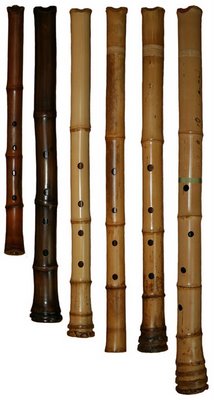Tips for aspiring jinashi shakuhachi makers
Occasionally, an aspiring shakuhachi maker asks for advice. These are some ideas which have proved important to me.
* Develop an understanding of the physics of wind instruments. Put it to practice. Realize what happens and why when any action is taken.
* Work with the idea of taking the path of least resistance. Since everything is connected, take action that will solve multiple problems. Juggle efficiently. Apply the least amount of action to make the best possible flute.
* Think big. Imagine the impossible. If one note plays particularly well. Imagine a flute where everything plays as well.
* Understand that there is no one ideal flute design. There are many different kinds of sounds that are satisfying.
* Realize that shakuhachi making is a matter of life and death.
* Play a lot. Find people who play better than you. Your flute making will improve dramatically.
* Work with responsibility. (This can not be overemphasized) You are representing an honorable profession. Understand your duty.
* Don't pose or misrepresent yourself. You'll disgrace yourself as well as other makers. You'll let down the bamboo. Allow yourself to develop honestly.
* Develop thick skin. Serious shakuhachi making will shatter your confidence. Persevere. You'll become stronger.
* Work with the bamboo and not at it.
* Approach each flute as a beginner, without pretense.
* With time and effort you'll develop your own sound. Use it to take the shakuhachi further.
Shakuhachi advice in video.
* Develop an understanding of the physics of wind instruments. Put it to practice. Realize what happens and why when any action is taken.
* Work with the idea of taking the path of least resistance. Since everything is connected, take action that will solve multiple problems. Juggle efficiently. Apply the least amount of action to make the best possible flute.
* Think big. Imagine the impossible. If one note plays particularly well. Imagine a flute where everything plays as well.
* Understand that there is no one ideal flute design. There are many different kinds of sounds that are satisfying.
* Realize that shakuhachi making is a matter of life and death.
* Play a lot. Find people who play better than you. Your flute making will improve dramatically.
* Work with responsibility. (This can not be overemphasized) You are representing an honorable profession. Understand your duty.
* Don't pose or misrepresent yourself. You'll disgrace yourself as well as other makers. You'll let down the bamboo. Allow yourself to develop honestly.
* Develop thick skin. Serious shakuhachi making will shatter your confidence. Persevere. You'll become stronger.
* Work with the bamboo and not at it.
* Approach each flute as a beginner, without pretense.
* With time and effort you'll develop your own sound. Use it to take the shakuhachi further.
Shakuhachi advice in video.

